As you may already know, Georgia is home to many great native plants. The state ranks seventh in the nation for native plant diversity. Native plants are an essential part of the ecosystem, and they support a variety of animals. By planting native plants, you can help make your community a more hospitable place for wildlife. In addition, native plants are incredibly beautiful; they come in all shapes and sizes and are a great way to spruce up your garden.
Let’s take a look at 11 native plants in Georgia that stand out.
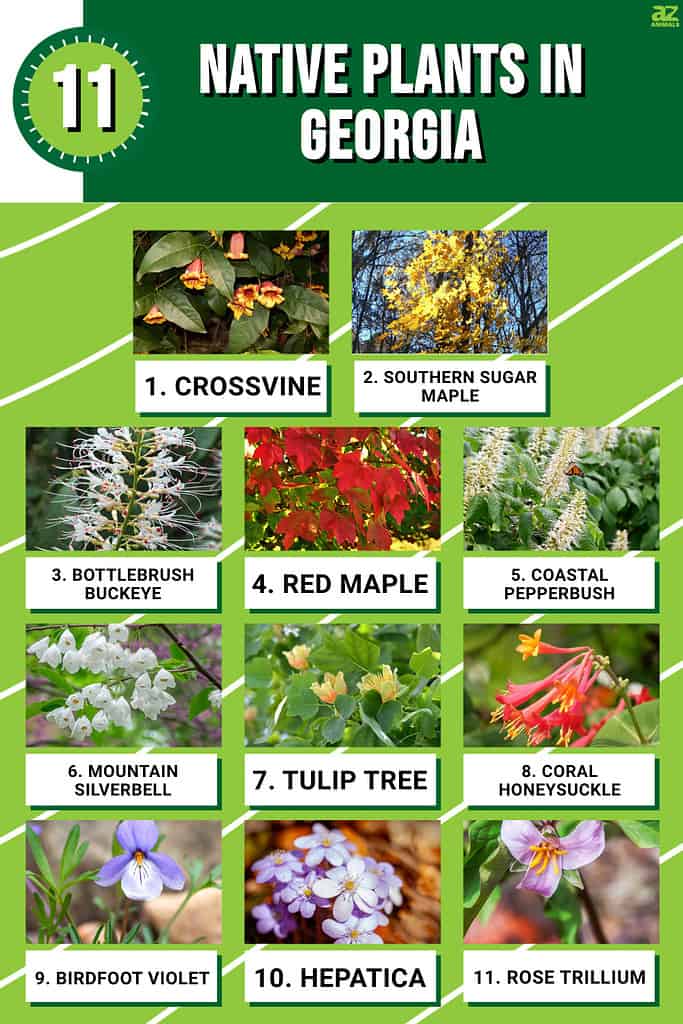
1. Crossvine (Bigonia capreolata)

The crossvine, also known as the trumpet flower, is a very versatile plant and can grow in various conditions.
©simona pavan/Shutterstock.com
The crossvine plant is a climbing vine that can grow up to 50 feet in length. It has dark green leaves and produces bright red or orange flowers. It’s native to the southeastern United States and can be found in states like Alabama, Florida, Georgia, Louisiana, Mississippi, North Carolina, South Carolina, and Tennessee.
Also referred to as the trumpet flower, it is a very versatile plant and can grow in various conditions. The wood from the vine is strong and flexible, making it ideal for use in baskets and other handmade items. The flowers are beautiful and make great additions to bouquets or floral arrangements. And in the past, the leaves were traditionally used as an herbal remedy for various ailments, such as colds, flu, and stomachaches.
2. Southern Sugar Maple (Acer floridanum)

The southern sugar maple is also known as the Florida maple and hammock maple.
©Tim Ross, Public domain, via Wikimedia Commons – License
The southern sugar maple plant is known for its sugar-rich sap, traditionally used to make syrup and sugar. This maple sap is rich in vitamins and minerals. Its leaves are large and have five lobes. They are dark green in color and turn bright and beautiful red, orange, and yellow in the fall. The wood is rugged and robust, making it a popular choice for furniture and flooring.
The southern sugar maple is a very resilient tree that can even be grown in hurricane zones. This tree can grow up to 75 feet tall and has a lifespan of over 200 years!
3. Bottlebrush Buckeye (Aesculus parviflora)

The bottlebrush buckeye’s flowers appear in clusters and bloom from June to July.
©Carmen Hauser/Shutterstock.com
The bottlebrush buckeye plant is a deciduous shrub that can grow to more than 8 feet tall and is typically found in wooded areas. The leaves are large and have a serrated edge. The shrub’s fruit ripens from September to October and appears as a dark brown capsule containing poisonous seeds if ingested, so keep them away from pets and young children!
As a fun fact, did you know that the bottlebrush buckeye gets its name from its bottle-shaped flowers? These flowers are rare, as most buckeyes have panicle- or spike-like inflorescences. The flower colors can range from white to pink, which bees love to pollinate. They appear in clusters, which bloom from June to July.
4. Red Maple (Acer rubrum)
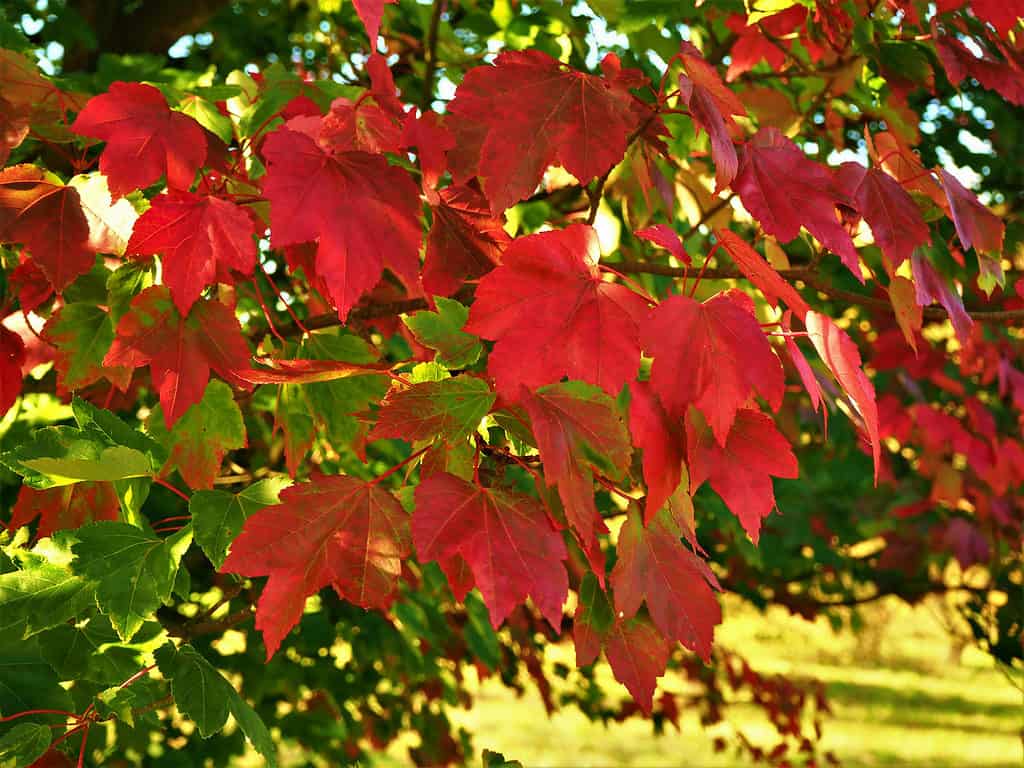
Red maples are especially abundant in the wetlands and swamps of Eastern Georgia.
©AngieC333/Shutterstock.com
The red maple tree is among the most common trees in Georgia and North America. Red maples thrive in wet soil. So, they are especially abundant in the wetlands and swamps of Eastern Georgia. These trees can be found in nearly every county and are a favorite among landscapers and homeowners alike.
Red maples are known for their brilliant red leaves in the fall, but did you know that they are also one of the first trees to bloom in spring? Their flowers are small and reddish, appearing before the leaves emerge.
Red maples can grow quite large, reaching heights of up to 40 feet (12 meters) and widths of up to 35 feet (10.6 meters). They have a relatively short lifespan compared to other trees, living an average of only 80 to 100 years. But don’t worry, they will provide you with plenty of shade and beauty in their lifetime!
5. Coastal Pepperbush (Clethra alnifolia)
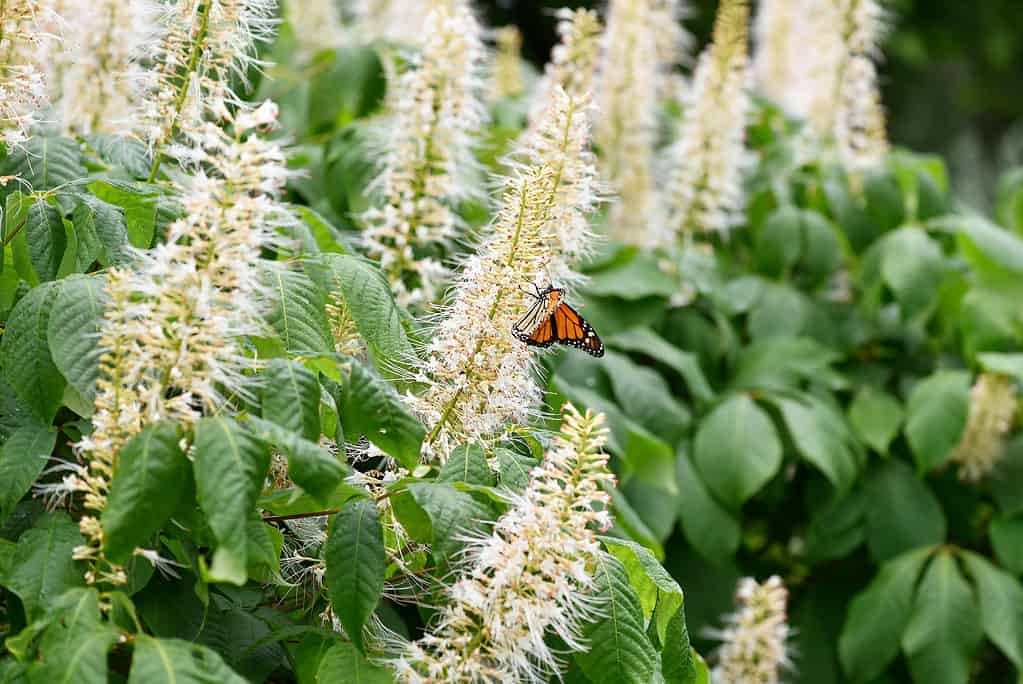
The coastal pepperbush’s flowers are small, white, fragrant, and bloom in late summer.
©Lana B/Shutterstock.com
The coastal pepperbush plant is a deciduous shrub that grows 6-12 feet tall and wide. Deciduous shrubs are a type of plant that lose their leaves in the fall and winter months. They are typically found in temperate climates and are known for their beautiful flowers and foliage. Other popular deciduous shrubs include azaleas, hydrangeas, and rhododendrons.
The coastal pepperbush has beautiful, dark green leaves that turn yellow, orange, or red in the fall. The flowers are small, white, and fragrant, and they bloom in late summer. It makes an excellent cut flower for any floral arrangements. The fruits are tiny capsules that contain black seeds.
This shrub is native to the southeastern United States, including Georgia. It grows best in full sun to partial shade with moist, well-drained soils. The plant is tolerant of salt spray and can be used as a hedge or screen if you live near the coast. It attracts butterflies and hummingbirds.
6. Mountain Silverbell (Halesia tetraptera)
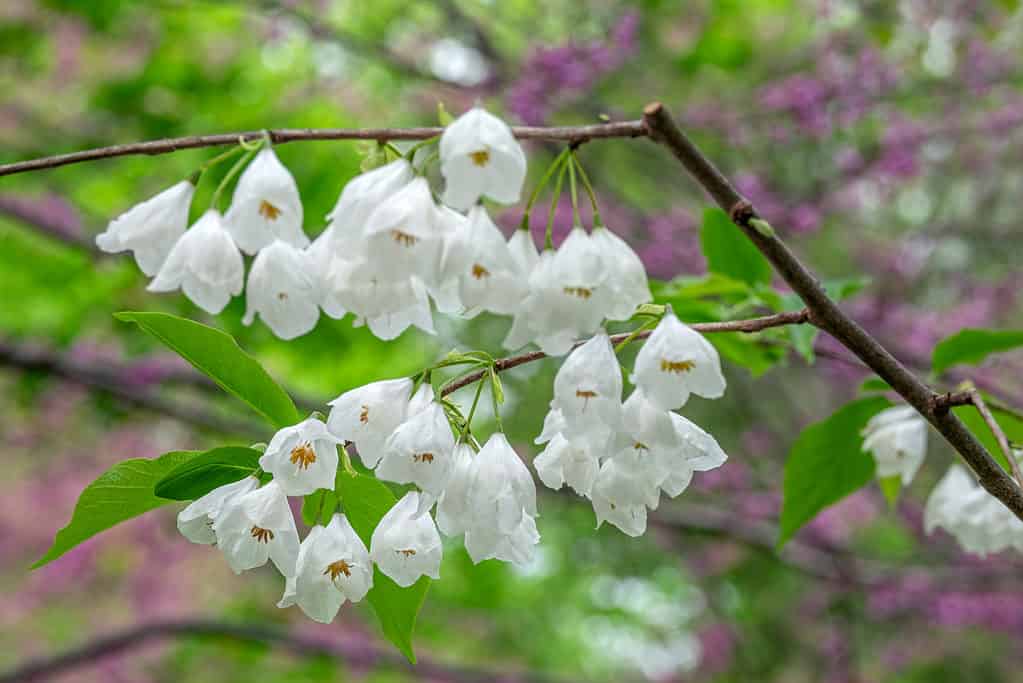
The flowers of the mountain silverbell are white or pale pink, and they bloom in late spring or early summer.
©Danita Delimont/Shutterstock.com
The beautiful mountain silverbell plant is found in Georgia and known for its white, delicate, bell-shaped flowers. The tree can grow to be around 30 to 40 feet tall and lives for more than 100 years. This tree thrives in the mountainous Appalachian region of northeastern Georgia, hence its name “mountain” silverbell.
The mountain silverbell is a member of the Styracaceae family, which includes the snowbell plant. The flowers of the mountain silverbell are white or pale pink, and they bloom in late spring or early summer. The fruits of this plant are small, round capsules that contain seeds.
The beauty of this plant makes it a popular choice for gardeners looking for native plants in Georgia. As a plus, the mountain silverbell is quite low maintenance, requiring average soil in full sun or even partial shade.
7. Tulip Tree (Liriodendron tulipifera)
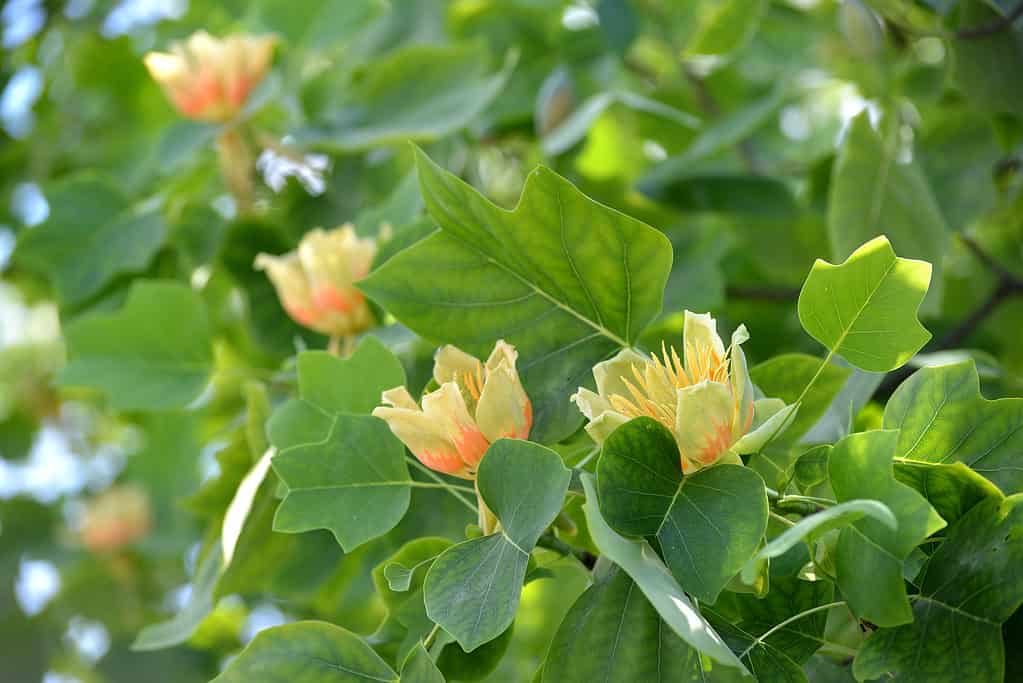
The tulip tree is the tallest hardwood tree in North America and can grow to over 200 feet tall!
©Irina Borsuchenko/Shutterstock.com
A member of the magnolia family, the tulip tree is native to eastern North America and can be found as far south as Georgia. The tulip tree gets its name from its tulip-shaped flowers. These flowers are usually yellow but can also be orange or green, and the flowers start to bloom from the beginning of April.
The tulip tree is the tallest hardwood tree in North America and can grow to over 200 feet tall! This hardwood tree is commonly used in woodworking to make furniture, cabinetry, and even musical instruments because the wood is solid and durable.
It is also a popular choice for landscaping because it’s such a beautiful plant, doesn’t require pruning or shaping, and can live in total sun exposure.
8. Coral Honeysuckle (Lonicera sempervirens)

Coral honeysuckle’s flowers and berries are not only beautiful, but can be used in salads and jams.
©shepherdsatellite/Shutterstock.com
The coral honeysuckle plant is a beautiful, evergreen vine native to the southeastern United States. It is commonly found in woodlands, along fences, and in gardens throughout the state of Georgia.
Coral honeysuckle can grow up to 20 feet long, and is known for its clusters of red or orange flowers that bloom from spring to summer and resemble an underwater coral garden. This plant is not only beautiful, but it’s also edible! The flowers and berries can be used in salads or made into jelly. Honeysuckle jelly recipes can be found online and are loved by many. Hummingbirds are attracted to the nectar-rich flowers, making the coral honeysuckle a great addition to any Georgia garden!
9. Birdfoot Violet (Vioala pedata)
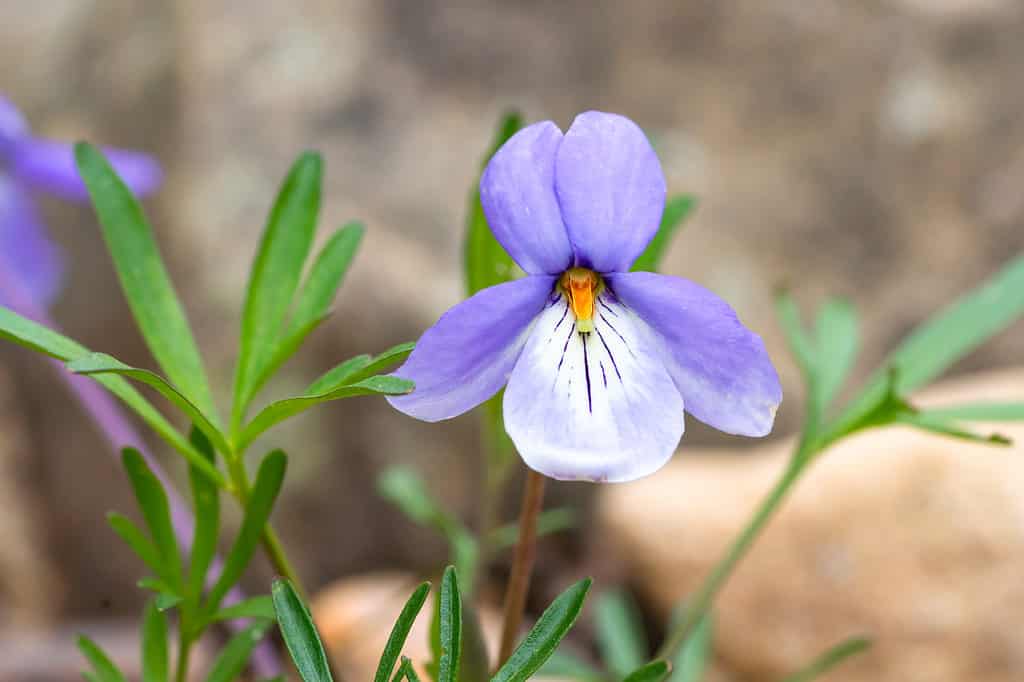
The birdfoot violet gets its name from the shape of its leaves, which are said to resemble a bird’s foot.
©Kimberly Boyles/Shutterstock.com
The beautiful birdfoot violet flower can be found in Georgia’s woodlands, prairies, and open fields. The birdfoot violet gets its name from the shape of its leaves, which are said to resemble a bird’s foot. These perennial flowers are typically blue or purple and bloom in the springtime.
The birdfoot violet is unique because it plays an essential role in the life cycle of many animals and insects. For example, bees rely on these flowers for nectar to make honey. So, next time you see a birdfoot violet, take a moment to appreciate not only the flower’s beauty but also all this little flower does for us and nature.
10. Hepatica (Hepatica americana)

The Hepatica plant has been used medicinally for centuries and was once thought to be a cure for liver diseases.
©Pandur/Shutterstock.com
Native to North America, the hepatica plant can be found in parts of North America, including Georgia, and in Europe and Asia. It belongs to the buttercup family, which includes around 2,252 species of flowers, and gets its name from the Greek word for “liver” because its leaves are thought to resemble the shape of a human liver.
Hepatica is found in woods and forest edges of Georgia and blooms from March to May. The flowers can be white, pink, or blue and have three petals with around 6 to 7 sepals.
This plant was used by Native Americans for medicinal purposes and once thought to be a cure for liver diseases. It is still used in traditional medicine, although its exact effects are not yet understood or proven. It has also been used as a dyestuff and as a food source.
11. Rose Trillium (Trillium catesbaei)
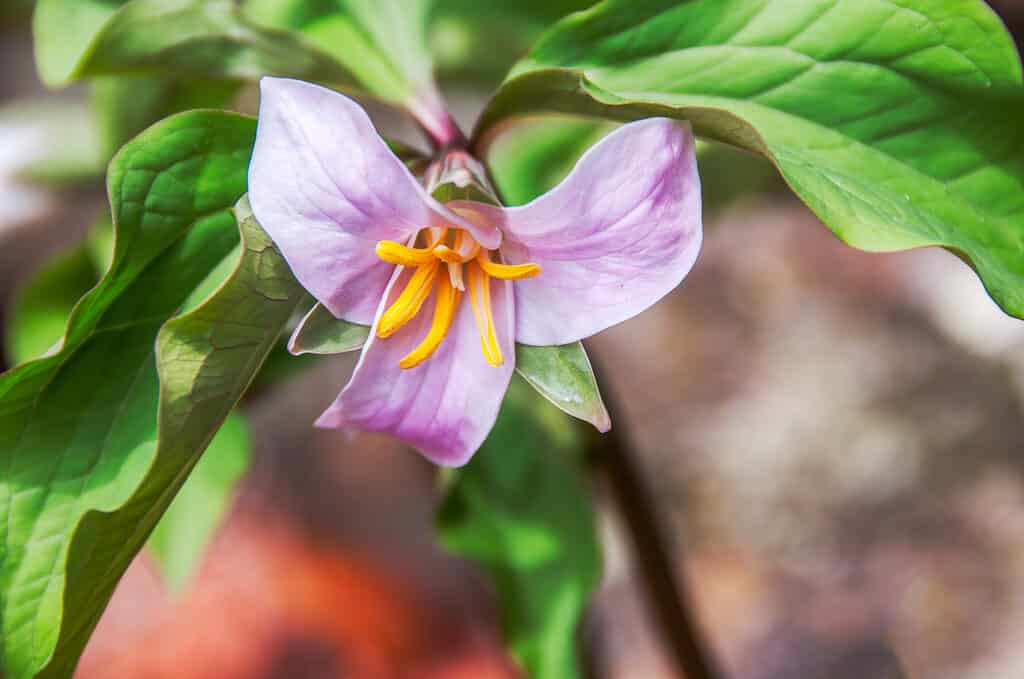
Rose trillium gets its name from its three-petaled pink flowers that bloom in the early spring.
©JayL/Shutterstock.com
The beautiful rose trillium plant is a lily family member native to the southeastern United States. It gets its name from its three-petaled pink flowers that bloom in the early spring. The blooms last throughout the spring and early summer before the flowers fade in color and eventually fall off. The leaves of the plant are large and heart-shaped.
This is a perennial plant that will come back year after year. Perennials are often used in landscaping because they provide color and interest throughout the year. They also require less maintenance than annual plants, which must be replanted yearly.
Rose trillium prefers shady, moist conditions and can grow in woods or near streams. This plant is a popular choice for gardeners and landscapers alike because of its unique appearance and lovely flowers. If you’re ever in Georgia, keep an eye out for this fascinating plant!
Summary of 11 Native Plants in Georgia
Here’s a recap of the 11 plants we took a look at that are native to the state of Georgia.
| Rank | Plant Name | Unique Features | Uses | Size |
|---|---|---|---|---|
| 1 | Crossvine (Bigonia capreolata) | Dark green foliage and orange or red blossoms | Basket weaving; making handmade items; flowers used in bouquets or arrangements | 50 feet long |
| 2 | Southern Sugar Maple (Acer floridanum) | Large, dark green, five-lobed leaves that turn flame-colored in the fall | Sap used to make syrup and sugar; wood is used for furniture and flooring | 75 feet tall |
| 3 | Bottlebrush Buckeye (Aesculus parviflora) | Large, serrated leaves and white floral clusters | Attracts pollinators such as bees | More than 8 feet tall |
| 4 | Red Maple (Acer rubrum) | Leaves turn a brilliant red in the fall; small reddish blooms | Shade and ornamental purposes | 40 feet tall |
| 5 | Coastal Pepperbush (Clethra alnifolia) | Dark green leaves that turn flame-colored during the fall; small fragrant white flowers | Ideal for floral arrangements; attracts pollinators such as butterflies and hummingbirds | 6-12 feet in height and width |
| 6 | Mountain Silverbell (Halesia tetraptera) | White, delicate, bell-shaped flowers | Low-maintenance, ornamental plant | 30-40 feet |
| 7 | Tulip Tree (Liriodendron tulipifera) | Tulip-shaped green, orange, or yellow flowers | Wood used in manufacturing furniture, cabinetry, and musical instruments | Over 200 feet |
| 8 | Coral Honeysuckle (Lonicera sempervirens) | Nectar-rich clusters of red or orange flowers | Edible fruit and flowers used in salads and for making jellies | 20 feet long |
| 9 | Birdfoot Violet (Vioala pedata) | Blue or purple flowers; three-lobed leaves resemble birds’ feet | Attracts pollinators such as bees | 4-8 inches |
| 10 | Hepatica (Hepatica americana) | Blue, pink, or white flowers | Used as a food source; attractive to bees | 6-9 inches |
| 11 | Rose Trillium (Trillium catesbaei) | Large, heart-shaped leaves; three-petaled pink flowers | Ideal for use as an ornamental plant | 12-18 inches |
The photo featured at the top of this post is © Carmen Hauser/Shutterstock.com
Thank you for reading! Have some feedback for us? Contact the AZ Animals editorial team.






